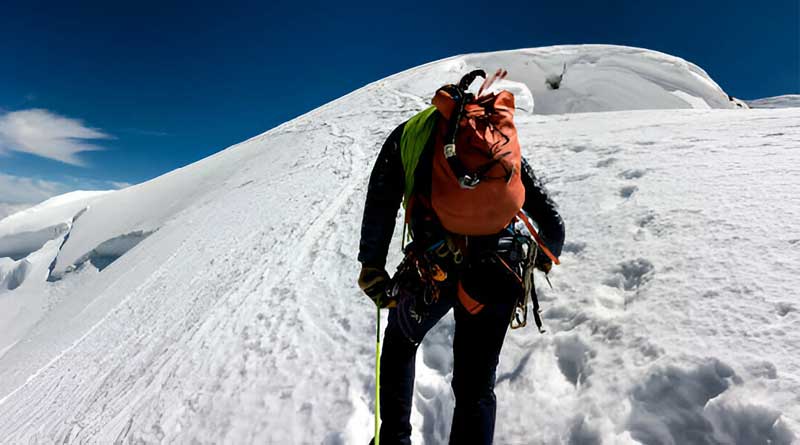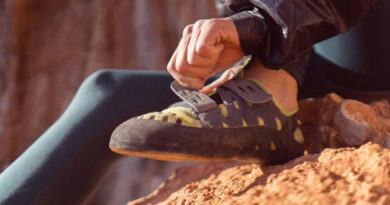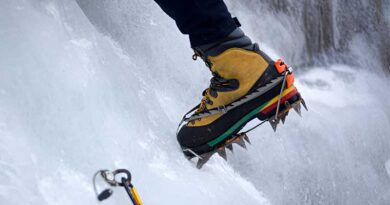Best Ice Climbing Backpacks of 2025
Ice climbing requires special gear, and having the right backpack is crucial. A good ice climbing backpack should be durable, comfortable, and designed for carrying ice tools and extra equipment. It should also be lightweight to avoid weighing you down during tough climbs. Whether you’re a beginner or an experienced climber, choosing the best backpack can make a big difference in your performance and comfort. In this guide, we’ll explore some of the top options available. We’ll look at their features, durability, and how they handle the demands of ice climbing. With the right backpack, you can focus more on the climb and less on your gear.
1. Osprey Zealot 30L

-
Volume: 30 liters
-
Weight: 1.3 kg
-
Material: 210D Nylon
-
Hydration reservoir compatible
The Osprey Zealot 30L is a versatile and durable backpack designed for serious ice climbers. Its compact 30-liter capacity is perfect for those looking to carry only the essentials, with room for tools, gear, and a hydration system. The backpack’s adjustable harness and hip belt ensure a snug fit, even when loaded up. The robust 210D nylon construction provides excellent durability, making it resistant to abrasions and wear, even in harsh ice climbing environments.
The Zealot is also designed with ice climbing-specific features such as tool attachment loops, reinforced areas for ice axes, and a stowable rope carrying system. Despite its relatively small size, it offers smart organization with a large main compartment and multiple smaller pockets to keep gear organized. Whether you’re scaling frozen waterfalls or ice-covered rock faces, the Osprey Zealot provides the functionality and comfort needed for a long day on the mountain.
Pros:
-
Hydration reservoir compatibility
-
Durable nylon construction
-
Well-organized with tool attachments
-
Comfortable, adjustable fit
Cons:
-
Slightly small for longer expeditions
-
Limited external storage options
2. PETZL BUG Backpack

-
Volume: 35 liters
-
Weight: 0.7 kg
-
Material: Polyester
-
Access: Top and front access
Review:
The PETZL BUG Backpack is a minimalist ice climbing pack that focuses on functionality and ease of use. At 35 liters, it offers enough space for your climbing gear while maintaining a lightweight profile. The top and front access zippers make it easy to quickly grab your gear without removing everything in the pack. This dual-access feature is particularly helpful when you’re on the go and need a specific item fast. The pack’s polyester material offers durability, but it’s lighter than other heavy-duty materials, giving it an edge for speed and mobility.
Designed with climbers in mind, the PETZL BUG features ice tool attachments and reinforced areas for protecting your gear. The simple, clean design minimizes unnecessary bulk, making it a great choice for those who prefer a streamlined, no-frills approach to their climbing gear. Despite the minimalistic approach, the PETZL BUG doesn’t sacrifice comfort, as its adjustable shoulder straps and padded back panel provide ample support during demanding climbs.
Pros:
-
Dual access for easy gear retrieval
-
Lightweight and durable
-
Minimalist design
-
Ice tool attachments
Cons:
-
May be too small for extended trips
-
Limited organizational compartments
3. Bseash 40L Waterproof Backpack

-
Volume: 40 liters
-
Weight: 1.1 kg
-
Material: Waterproof PVC
-
Roll-top closure
The Bseash 40L Waterproof Backpack offers an excellent balance between size and weather resistance, making it ideal for ice climbers who need to protect their gear from the elements. The waterproof PVC material ensures your equipment stays dry even in the most extreme conditions. Its roll-top closure provides flexibility, allowing you to expand the capacity when needed. This feature is especially beneficial for carrying extra gear like ropes, helmets, or layered clothing, while still maintaining water resistance.
In addition to its weatherproof design, the Bseash backpack offers ample storage space for a variety of climbing tools. The large main compartment easily accommodates bulky items, and the exterior has multiple attachment points for gear like ice axes and ropes. Though not as feature-rich as some other climbing packs, the waterproofing and rugged build of the Bseash make it an excellent choice for climbers in wet, cold environments.
Pros:
-
Waterproof PVC construction
-
Roll-top closure for expanded capacity
-
Large main compartment
-
Multiple external attachment points
Cons:
-
No dedicated compartments for smaller items
-
Heavier than some ultralight options
4. Osprey Mutant 38L

-
Volume: 38 liters
-
Weight: 1.4 kg
-
Material: 210D Nylon Ripstop
-
Features: Rope carrying system
The Osprey Mutant 38L is a rugged and versatile climbing pack designed for both alpine and ice climbers. The 38-liter capacity offers a nice balance of space and portability, making it suitable for day trips or multi-pitch climbs. The bag’s 210D nylon ripstop fabric ensures it stands up to the rigors of ice climbing, while the rope carrying system allows you to easily pack a rope without compromising space. The hip belt and padded straps provide excellent comfort and support, which is crucial for carrying a heavy load across varied terrain.
With multiple ice tool attachment points, reinforced areas for ice axes, and a simple but effective design, the Mutant 38L delivers functionality without unnecessary bulk. It is highly adaptable, offering front and top access for easy retrieval of gear. While it may not have as many organizational features as some competitors, the Osprey Mutant stands out for its durability and well-thought-out features for climbers who prioritize practicality.
Pros:
-
Durable nylon ripstop fabric
-
Convenient rope carrying system
-
Comfortable and supportive fit
-
Ideal for alpine and ice climbing
Cons:
-
Limited internal organization
-
Heavier than some other climbing backpacks
5. GYDEHUTJ Climbing Bag

-
Volume: 35 liters
-
Weight: 1.3 kg
-
Material: Oxford fabric
-
Ice tool attachments
The GYDEHUTJ Climbing Bag is designed with the ice climber in mind, offering a solid 35-liter capacity for carrying essential climbing gear. The durable Oxford fabric resists abrasions, and its sleek, streamlined design reduces the overall weight without sacrificing durability. The bag includes ice tool attachments, allowing you to easily secure your climbing tools while on the go. The bag’s compact size makes it a good option for climbers who want to carry only the most essential gear without unnecessary bulk.
The GYDEHUTJ is equipped with adjustable shoulder straps and a padded back panel for increased comfort during long hikes or intense climbs. While its simplicity makes it easy to use, some climbers might find the bag lacking in internal compartments for organizing smaller gear. Nonetheless, its sturdy construction and practical features make it a solid choice for those focused on performance and minimalism.
Pros:
-
Durable Oxford fabric
-
Ice tool attachments
-
Comfortable, padded straps
-
Lightweight and compact
Cons:
-
Few internal organization options
-
Lacks additional compartments
6. BeeGreen Drawstring Backpack

-
Volume: 20 liters
-
Weight: 0.4 kg
-
Material: Polyester
-
Closure: Drawstring
The BeeGreen Drawstring Backpack is a budget option for ice climbers who need a lightweight and compact solution. At 20 liters, it’s more of a day-use bag, ideal for carrying just the essentials. The polyester material is durable and can withstand the rigors of short climbs or hiking. The drawstring closure makes it easy to access gear quickly, but it might not offer the same level of security as more traditional zippered designs. This simplicity can be both an advantage and a limitation, depending on your needs.
While it’s not specifically designed for ice climbing, the BeeGreen backpack can still hold smaller tools and items like gloves, snacks, or a first aid kit. It’s perfect for light day trips or when you want a secondary, smaller bag to carry items that don’t fit in a larger pack. The lightweight nature of the bag ensures you’re not weighed down during quick ascents or descents.
Pros:
-
Lightweight and compact
-
Simple, no-fuss design
-
Ideal for short climbs or hiking
-
Affordable
Cons:
-
Limited capacity
-
Lack of organization features
7. Asana Climbing Gym Backpack

-
Volume: 25 liters
-
Weight: 0.9 kg
-
Material: 600D Polyester
-
Padded shoulder straps
The Asana Climbing Gym Backpack is a cheap option that excels as both a climbing and gym bag. With a 25-liter capacity, it is compact but spacious enough for gym gear and climbing essentials. Made from durable 600D polyester, it offers good resistance to wear and tear, while its padded shoulder straps ensure comfort even when carrying heavier loads. The bag includes a main compartment for clothes and shoes, and smaller side pockets for your smaller gear like chalk bags, water bottles, or tape.
While it’s not specifically designed for ice climbing, the Asana backpack works well for indoor or sport climbers. The streamlined design makes it easy to organize your gear without unnecessary bulk. Its lightweight construction, combined with the padded straps, makes it a great option for those looking for a simple, functional bag that can handle both climbing gym sessions and outdoor trips.
Pros:
-
Versatile for both gym and climbing
-
Durable 600D polyester
-
Comfortable, padded straps
-
Compact and well-organized
Cons:
-
Smaller capacity for alpine/ice climbs
-
Limited external attachment points




